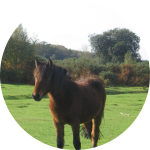| Home |
Welcome to the Horse Stall |
|
Horse Stall contains all types of information for Horse Lovers.
There are a number of products branded horse gifts and products.
Horse Articles :: Horse Breed Glossary - G
|
Horse Breed Glossary - G |
|
GALICIAN PONY Found in northwest Spain, The Galician Pony is home in a region that features many mountains and a wet climate. The breed is used for the production of meat and for riding. The breed was used to develop the Galiceno, and it's size is between a pony and a horse. The Galician Pony comes from a mix of Roman and Celtic horses that were brought into Spain by the Suevos. They have short bodies and strong legs. Most have chesnut colored coats. While valuable in their meat production uses, they also have tourist value. There is a festival in Galicia that is called "Curros". During this festival, everyone participates in catching semi-wild horses from the Galician mountains to brand and cut manes and tails to sell them in the "curro". Some of the horses are purchased and the rest are set free to the mountains again. GELDERLANDER HORSE The Gelderlander breed comes from the Dutch Province with the same name, known for their excellent horse breeding traditions. The Gelderlander breed is a result from crossbreeding between local breeds like the Fiesian, and imported breeds including the Thoroughbred, Oldenburg, East Friesian, Hackney and Anglo-Norman. The original use for Gelderlander horses was for agricultural work and road harness, but more recently the Gelderland has been a riding horse with superior jumping ability. The Gelderlander's appearance features a convex nose and a plain head. Their tails are held high. They are about 15 or 16 hands in height, chestnut and gray colored and often have white markings on legs and face. The Gelderlander horse breed is considered demonstration of the successful breeding of many different types of horses. It has the best qualities of each of the horse types in it's bloodlines. GIDRAN HORSE In 1816, when a desert bred Arabian was imported to the Mezohegyes State Stud, the Gidran breed was developed. Breeding continued with Arabian, Spanish-Naples, Turkish and Transylvanian mares and the colts from the mares led the breeding of the new breed, Gidran. Modern Gidran horses are quality riding and driving horses with recognition in competitions held internationally. They have well balanced temperaments, great athletic abilities and sturdy builds. There are less than 200 Gidran horses in the world, and their size ranges from 15 to 17 hands. GOLDEN AMERICAN SADDLEBRED HORSE Golden American Saddlebreds have gorgeous and well proportioned heads. Their ears are erect and small. They give off an appearance of elegance with long necks and well sloped shoulders. They have long legs with sloping pasterns that make them a comfortable riding horse. They are usually between 1000 and 1200 pounds, and 15 to 17 hands in height. Coloring of the Golden American Saddlebred will range from a copper to a cream color, and include many variations of shades in between. The ideal color of the breed is similar to a gold coin- hence the breed's name! The mane and tail of a Golden American Saddlebred is white. One of the easiest horses to train, the American Saddlebred is adaptable to most conditions. Some of the horses in the breed excel on the trails while others are better in the show ring. GOTLAND HORSE Sweden's primordial horse breed, Gotland, still live on the land in the woods of Gotland, as they have for thousands of years. They are a living relic of the past. The history of the Gotland horse breed is a bit mysterious, but discoveries from the Stone Age lead people to believe the Gotland has been roaming the land for about 5,000 years or more. The oldest reference to the pony is found in 13th century legal code, in Skanelagen, with mention of "the wild horses of Gotland." In the 18th Century, many references of the Gotland pony are found. By the 19th century, the ponies were found throughout Gotland on large forest and within the center of the island. Farmers were using Gotland Ponies as draft horses on their farms. The number of Gotland ponies dropped in the middle of the 19th century, as many were sold to Germany and England for mining and chore work. As the forests in Gotland were cultivated for farmers, the ponies were seen as pests because they began trampling the newly built fences for the farmers. Only about 150 Gotland ponies remained in the beginning of the 20th century, but the Gotland Agricultural Society set out ot save the Gotland Pony. They fenced in over 200 acres of land and captured 5 Gotland Ponies to live there. Soon, a clan of Gotland ponies developed, and it was these horses that were uesed for breeding in an effort to maintain the breed. Most Gotland ponies are black, sorrels, bays or buckskins. When a foal is born of light coloring, it is considered undesirable as there is a risk of breeding of two light colored Gotland ponies resulting in an Albino. Albino horses have skin that is overly sensitive to sun exposure. Gotland ponies are used as children's horses, for dressage, jumping, trotting and driving. To obtain a pedigree, the breed must produce a horse that is 45 to 51 inches in height, with an energetic disposition. In Sweeden, there are about 9,000 Gotland ponies, with more found in Finland, Denmark and the USA. About the Author |
Top Horses |
|
| Top Horse Movies | |
Horse Resources |
|
Horse Health |
|
Horse Breeds |
|
More Horses |
|


| Copyright 2005-2021 DR Management All rights reserved |
Dog Gifts | Wildlife Gifts | Handmade Horse Gifts |
